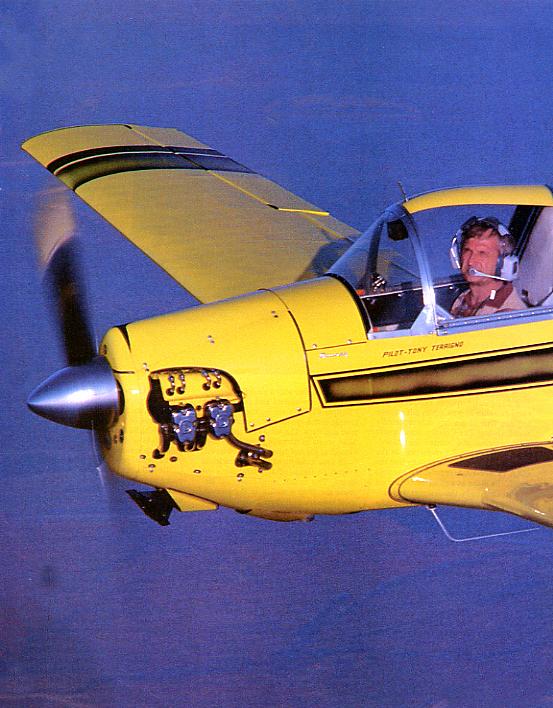
Small Mooney is "Mitey" Impressive
Mooney Mite fan has a 35-year love for a compact, 65-hp aircraft.
Photos and words by Don Downie
THE CLICHE "good things come in small packages" may be fine for economy cars, poodles and blondes, but is it really true when it comes to airplanes? Tony Terrigno of Buena Park, California, thinks so. Tony's love affair with the compact Mooney Mite began in 1948 when he saw one on a nationwide factory tour. The trim little single-seater landed at the grass strip of Cernard in Youngstown, Ohio, Tony's hometown. "I said to myself, 'Someday, I'm going to own one,' " remembered Tony.
Twenty-five years later, a magazine article on the little Mooney Mite rekindled Tony's interest. After seven months of searching, he finally found one that might be for sale. The owner, who lived in Weiser, Idaho, was never home when Tony called, so the owner-to-be finally waited until Christmas day when everyone is supposed to be at home. Sure enough, the owner answered. They made a deal over the phone, and soon Tony was the proud owner of production M-18-L Mite, Serial Number 79 (L for Lycoming), built in April, 1950.
 |
Tony put the Mite in his hangar at the Corona, California, Airport and went through the plane from one end to the other. He took 20 months to restore the little single-seater to its original condition. The wood proved good and he recovered only as necessary. When the project was completed he appeared at most of the local fly-ins and garnered his share of trophies.
He also found another Mooney Mite, Serial Number 81 on the production line as the last of the Lycoming series. His second Mooney went into the back of his hangar for restoration. In all, 287 Mites were built, but after Number 81, all had 65-hp Continental engines.
Tony took his Number 79 to Oshkosh in 1980 and won the award for best aircraft built in limited production. He also met a persistent buyer. Tony really didn't want to sell his spick-and-span Mite, but the Mooney fan kept dropping by every day and finally made Tony an offer he couldn't refuse. "I would never have sold it if I hadn't had the second airplane 80% rebuilt at that time," Tony said. "I normally don't drink, but I had two glasses of wine that day before I got on the airline back to southern California."
Number 81, N118C went to Oshkosh in 1982, but this time the owner brought it back to the West Coast, after winning the top award for 0-100 hp in the classic division.
N118C is not strictly stock. The Lycoming 0-145-B-2 has twin ignition. There's a 720 Edo-Aire with a VOR head, a Collins transponder for the high-density traffic in southern California and an electric bank-and-turn indicator, although the ship is not fully IFR equipped. Tony has installed non-standard nosegear doors and a larger spinner and has chromed the engine rocker box covers. Tony figures 112 mph at 75% power on 3.3 gph. He averages about 100 hours per year flying time in the single seater.
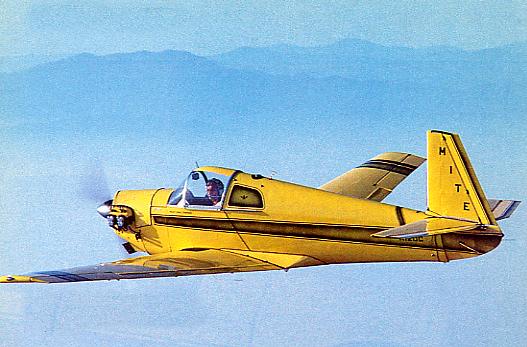 |
An estimated 140 Mites still are registered with the FAA with about 80 flying and perhaps another 25 sitting around in various stages of disrepair. In California alone, 28 are known to be flying.
Tony has formed the Western Association of Mooney Mite Owners (WAMM- why isn't it WAMMO?). He produces a regular newsletter, either bimonthly or when there's sufficient material. The newsletter is sent to the group's 47 members, all of whom either own or are previous owners of Mooney Mites. New owners can contact Tony at 5409 Barrett Circle, Buena Park, CA 90621.
I almost first met Tony Terrigno when he and his mighty Mite taxied out from the gas pit at Tucurncari, New Mexico, on the way to Oshkosh '82. I did admire the Mite at the EAA Show and finally talked with Tony after we both landed at Topeka, Kansas, at the same time for fuel and lunch on the return flight from Oshkosh. (Good airport cafe there!) It was at the stop in the Midwest that we arranged to meet again in California to take photos of N118C.
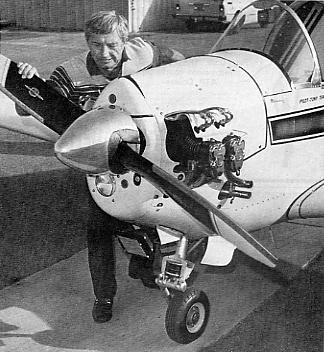 |
Terrigno began flying in 1942 and has amassed 5000 hours of power time and another 1400 hours in sailplanes. Over the years he has owned a Cessna 140, 172 and a PT-19 in addition to the two Mooney Mites. He has been a glider instructor on weekends for the Orange County Soaring Association for the past 18 years. During the week, he is employed by Hughes Aircraft Co. as ground support systems group technical director of company production.
It was natural for Tony to be interested in aviation because his father was a World War I fighter pilot in the Italian Air Force. He was shot down and slightly burned.
Tony was a U.S. Navy blimp crewman active in World War II anti-submarine warfare. "I love to fly, particularly early in the mornings. I like to discover new areas in the mountains," Tony said. "Because of my sailplane training, I like to fly very slow and very low around mountains where I'm not near populated areas."
Perhaps one of the reasons Tony likes his single-place Mite is that his wife Thelma really doesn't like to fly in little airplanes. However, Tony's sons Larry and Jimmy are both pilots; Larry is licensed in power planes and Jimmy in gliders. Jimmy, at 14 years, 4 months, was the youngest pilot to receive the SSA "Silver C" badge.
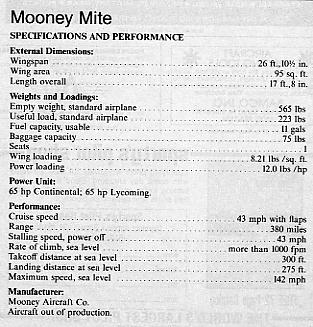 |
Bits and pieces of a Piper Tri-Pacer he is restoring and changing back to a Pacer taildragger are stored in his hangar. He also owns a single-place PIK-20D sailplane from Finland.
Tony grins when people ask if his present Mite is for sale. "Sure, I tell them I'll sell it for something over $25,000, but there are some special conditions. I'll take $15,000 down and the balance in five years when I deliver it to them," he says with a big grin.
The Mooney Mite was developed as a low-cost flying machine by Al Mooney and D.G. Yankey. The pair formerly headed the Culver Aircraft Corp., which went out of business early in the "iron bird" era. Before designing the Mite, Al Mooney already had created the Culver Cadet, some Monocoupes, the Dart and the Eaglerock Bullet.
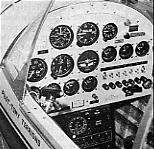 |
Shops were set up near Wichita in 1948 and part-time help was obtained from other aircraft plants. The prototype Mite and four subsequent models were equipped with 26-hp Crosley automotive engines. One of the originals reportedly is still flying. The Crosley version was fabric-covered and utilized four Goodyear belts with a 2:1 reduction to the prop. In those days, the factory had the CAA (a pre-FAA regulatory agency) certify the plane as well as the converted engine. Originally, the designer was considering either a Waukesha or a Hercules powerplant, but changed to the Crosley which was being used to power U.S. Navy electric generators. It was a heavy powerplant, 4 pounds per horsepower with 1.8 quarts of liquid coolant. Take off performance was rated poor with a 15-second roll considered normal. The Crosley also iced up very quickly. However, fuel consumption was down to 1.55 gph.
The original factory price was $1995! Mites now sell for between $5000 and $8500, depending on condition and equipment.
After the Crosley automotive engine was discontinued, the factory designations were M-18-L and M-18-LA for Lycoming; M-18-C and M-18-C55 for Continental powerplants. All these engines were 65 hp. The M-18-C55 was produced in 1955, the last production year. Of this group, 32 or so were the "stretched" version with the cockpit three inches longer, one inch wider and inches higher with a modified canopy.
Mooney developed and patented the "Simpli-Fly" system on the Mite. One simple hand-crank integrated control trim and flaps. The whole tail unit of the Mite pivots in trimming and 16.5° flaps extend as the tail trim passes 3/4 travel.
To save weight and cost, no electrical system or lights of any kind were on board. This meant hand-propping. Because the prop is so low to the ground, most owners pull their props through seaplane fashion from behind.
Soundproofing was nowhere to be found in the original production models and instruments were kept to bare necessities. Originally, the fuel tank behind the pilot's head would carry seven gallons and six pints, and the baggage compartment would hold 20 pounds. Both were expanded when larger engines replaced the heavy automotive engine. Later models carried 14 gallons of fuel and had a 75-pound baggage capacity.
The Mite was produced with a unique gear-warning system. An automotive windshield wiper was connected to the intake manifold and would wag a red disk back and forth when the throttle was retarded if the gear was not down and locked.
Economics and the labor market dictated a move by Mooney to the wide-open spaces of Kerrville, Texas, in 1952. Although Mooney is still there, the Mite did not survive the final blow when Continental stopped building the A-65 engine. No comparable Lycoming was available, and Mooney was already in production on the more profitable four-place M-20. So the Mite was discontinued after eight years of production and 287 units with various powerplants.
In a special production for the military COIN (Counter Insurgency) armed light plane competition, one Mite, the M19, was built around an M-18-C55 fuselage and powered with a C-90 Continental. This special unit sported two 30-caliber machine guns. Other entries in the COIN competition were John Thorp's Fletcher FD-25 and a special Swift. Tony believes that the remains of the COIN Mooney are "someplace in Texas. It crashed some years ago while attempting a takeoff with a large stone tied to its tail tiedown."
An attempt was made to sell the Mite in kit form after factory production closed down. In 1977, Fred H. Quarles of Charlottesville, Virginia, attempted to merchandise a computer-programmed kit. More than 4000 pieces reportedly were included and the price was $5995. Advertisements for the kits claimed, "We've developed a materials list that checks off the smallest nut and bolt. We've developed a computerized quality control system that assures the builder of no long waits for bits and pieces. And now, we've put it together in a complex kit package. Everything is indexed and cross-indexed. The only thing more we could do to make it available to you is build it ourselves. Rather than have you wait for us to develop manufacturing facilities, we'll provide inspiration to help you get flying." Unfortunately, the kits didn't make it. To Tony Terrigno's knowledge, only one kit had been sold.
During the Mite's heyday, some operators would lift the little airplane off the ground, support it on a couple of saw horses and let the student operate the manual gear while still safely on the ground. It took a trick and a flick of the wrist to stow the Mite's gear. Even today, you can frequently see a wobble during climbout as the pilot reaches down and pulls up on the gear handle.
Some FBOs used to issue a hold-harmless agreement to be signed prior to renting their Mite. It called for a fixed charge of $65 for a gear-up landing on grass or $85 for a goofed landing on pavement. In those days, you could replace the wooden prop and smooth out the dings after a gear-up mishap. Today, one aviation reporter commented gleefully, "Operators renting Mooneys are finding that folks who used to fly together are now renting two or three single-seaters for breakfast flying and Sunday sport."
Describing the initial Mite in a 1948 publication, the inimitable Max Karant stated, "This is the first time I've ever strapped an airplane on my pants and flown away. The Mooney M-18 is so tiny that you almost 'strap it on' to fly it."
My personal logbook shows a flight in a Mite back when they were new. A now-defunct aviation magazine carried my report on N353A, first of the 65-hp Lycoming models to reach the west coast. Back in those days, we reported that the Mite would fly 100 miles on 80 cents worth of fuel.
"I'll take $15,000 down and the balance in five years when I deliver it to them." -- Tony Terrigno
West coast distributor Harry Yoyster, then located at Clover Field in Santa Monica, California, had the following requirements for rental of a Mite:
1. Possession of at least a private license;
2. At least five takeoffs and landings within the past 60 days;
3. At least 50 hours in an aircraft of 90 hp or less;
4. For a pilot who has never flown a Mooney Mite, there must be a check ride in an aircraft of 90 hp or less prior to first flight in the Mooney.
The instructions I received were succinct. "You just get in and fly it. Come on out to the shop and I'll show you how to get the landing gear up. After that, you're strictly on your own." Ah, for those days again!
In my initial Mite flight from the long-defunct Las Vegas Sky Corral Airport, I was very impressed with the rate of climb. In fact, I clocked the Mite at exactly 14 minutes from the 2200-foot-high Sky Corral to 12000 feet. Service ceiling Was a whopping 21,000 feet. After my flight, I wrote, "This flying high and on your own is really quite a novelty. With the exception of a few military pursuit pilots, very few fliers have logged any time in single-seat equipment. There are absolutely no distractions: no instructor to ask questions of, no passengers with whom to jabber and no radio to talk over. This lonesome feeling gives the pilot that seldom-realized opportunity to grasp the vastness and magnitude of the sky that each student feels when he first solos . . . If you can fly alone and love it, be sure to try the Mooney Mite."
In today's era of metal and carbon fiber structures, a wooden airplane is considered by many to be an antique. And like most antiques, it does take some TLC and careful inspection. Some Mites have come apart in flight from deterioration of glue joints and rot and rusting of the nails used in initial assembly. Owners of the older Mooneys, including the Mite, can spend a considerable amount of money on detailed annual inspections. Heat and humidity do the most damage. Mite owners go to extremes to keep their little birds out of the rain and snow. Because engine oil is just as destructive to wood as moisture. Mite owners are more careful than most to keep their ships spotless. As one Mite owner quipped, "At least you don't have to worry about metal fatigue."
In its advertising, the Mite has been described as "The most fun airplane ever built." Tony Terrigno and his WAMM members are tangible proof of that statement.
This article by Don Downie was originally published in the January 1984 issue of PRIVATE PILOT. The earlier report that Don refers to is "Pilot's Report ... the Mooney Mite" which is also found on our Articles page. Thanks to Garry Gramman for this material.
As a matter of interest, Tony Terrigno reluctantly sold N120C in February of this year. He got the price he asked for. The aircraft now belongs to Ted Reusch of Chino, CA.
May 25, 2000